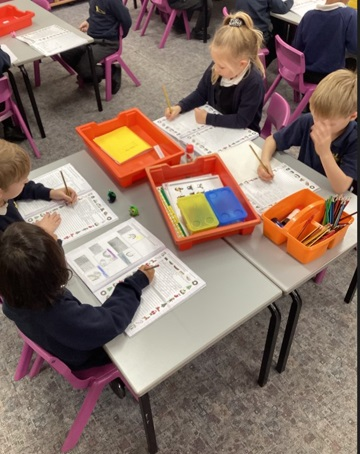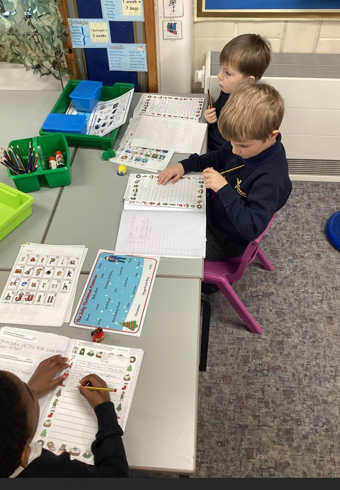English is at the core of our teaching at Wheatfields. Reading and writing are essential life skills and are developed throughout a child’s time at the school. While Reading and Writing are taught discretely, they are also woven through all of the curriculum and help to equip the children to become lifelong learners.
AIMS
The aims of teaching English are:
- to enable children to speak clearly and audibly, and to take account of their listeners;
- to teach children effective communication, both verbal and non-verbal, through a variety of drama activities;
- to help them become confident, enthusiastic and independent readers, through an appropriate focus on word-, sentence- and text-level knowledge;
- to foster the enjoyment of writing, and a recognition of its value;
- to encourage accurate and meaningful writing, be it narrative or non-fiction;
- to enable the children to use the correct spelling, grammar and punctuation;
- to help children develop a fluent, joined style of handwriting using the cursive style.
SPEAKING AND LISTENING
We recognise the importance of spoken language in pupils’ development across the whole curriculum - spoken language underpins the development of reading and writing. Children are encouraged to develop effective communication skills in readiness for later life.
Opportunities to develop these skills include; an annual public speaking competition, class assemblies, talk partners, drama and performances. All of the speaking and listening skills are taught in English, across the curriculum and during extra-curricular activities too.
We recognise the need for all pupils to speak, read and write Standard English fluently and accurately, while acknowledging that a pupil's own dialect, or other language is of prime importance. It is our school policy to encourage children to use Standard English.
READING
Reading is the gateway to all learning and is at the heart of our learning here at Wheatfields. We want all children to develop the skills to enable them to read fluently and with understanding. We also provide texts, experiences and learning which promote a love of reading.
We use ELS to deliver daily discrete phonics lessons in FS and KS1, enabling children to decode efficiently. This is continued into KS2 where necessary.
Teachers model reading strategies during shared reading sessions with groups or the whole class. Children have the opportunity to develop reading strategies and to discuss texts in detail during guided reading sessions. These may be taught as a whole class or in smaller groups. Children are given time every day to read for pleasure. In every classroom there is a reading corner and a range of books to enjoy.
Reading with a partner
Across years 2 to 6 we use Accelerated Reader to help the children develop their reading skills and their enthusiasm for reading. Accelerated Reader is a system that enables the children to develop their love of reading. Every time they finish a book, they can do a quiz on the book and, if they pass the quiz, they are awarded the number of words that are in the book. Our children are proud of their personal word count as well as their class totals.
Many exciting and rewarding activities are arranged in school to promote the pleasure and knowledge that can be gained from books, i.e. Book Fair, World Book Day and Book Jam. All children are also involved in judging the Read It Again awards, giving them the opportunity to read acclaimed recently published texts. Some children have the opportunity to engage in discussions about the texts with peers from across the county and some of the authors themselves.
We recognise the value of adults (both in school and at home) reading aloud to children, in order to improve their grasp of story language, enthuse them with a love of books and inspire them as writers. We have regular Stay and Read sessions in school where we invite parents to come into school and read with their children.Reading at home is an important part of learning. Children receive dojo points every time they read at home and, if they read five times in a week, they enter a half-termly raffle in their phase for a book token.
WRITING
We aim to develop the children’s ability to produce well-structured, detailed writing in which the meaning is made clear and which engages the interest of the reader. Attention is paid throughout the school to the formal structures of English, grammatical detail, punctuation and spelling. Our approach to teaching writing covers the ‘transcription’ and ‘composition’ requirements of The National Curriculum (2013). Teachers are flexible in their selection of Literacy experts’ strategies to suit the needs of the children and text type being taught (for example Ros Wilson and Pie Corbett).
Children are encouraged to take pride in their writing and strive to do their best at all times. We believe that the children learn best when they are writing for a purpose. This purpose is at the core of the unit of work and gives the children a focus. We also have an audience for our final piece of writing in a unit. Examples across the school include writing a picture book for younger children, creating leaflets for visitors at a place of interest and writing poetry to perform to peers. The children encounter a range of text types and genres across the school (see the attached English Overview table at the bottom of the page).
GRAMMAR AND SPELLING
The teaching of Grammar and Spelling is in line with the requirements of The National Curriculum (2014). Grammar is usually taught as part of the English lesson but is reinforced across the curriculum. Children are taught grammatical rules and given time to practise these and embed them.
To be able to spell correctly is a life skill. When spelling becomes automatic, pupils are able to concentrate on the content of their writing and the making of meaning. Whilst we note that spelling is not the most important aspect of writing, confidence in spelling can have a profound effect on the writer’s self-image.
From year 2, when the children move on from their phonics lessons, we follow the Jane Considine spelling Programme up to year 6. We believe that this enables the children to develop their understanding of spelling patterns and rules across the school. Words and spelling patterns are displayed in classrooms to support the children’s learning.
HANDWRITING
By the time the children are in year 4, it is our expectation that they will have developed a joined, cursive handwriting style.
In Early Years the children are taught basic letter formation for all upper and lower case letters. In year 1 we move onto pre-cursive letter formation before we begin to introduce joining when the children are ready in year 2 or year 3. The joins are taught and refined across years 3 and 4. When the child has developed a neat joined handwriting style they will earn their pen licence. This gives the opportunity to write using a pen in their books. During year 5 and 6 the expectation is that children embed their good practice and develop the ability to write more quickly before transitioning to secondary school.
SPECIAL EDUCATIONAL NEEDS AND ENGLISH





